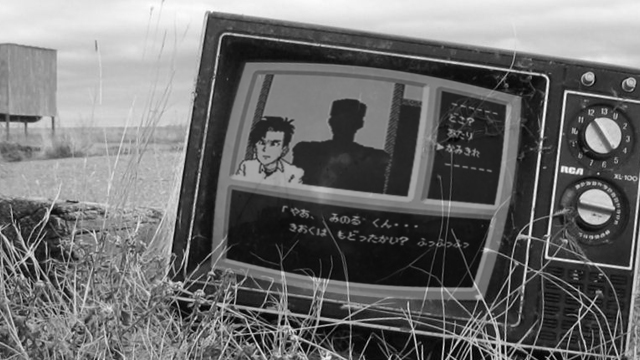 Ask anyone what they know about Nintendo– or, heck, video games– and they’ll more likely than not talk about Mario. Of course, it’s not really unexpected, considering the plumber was at one point more recognized than Mickey Mouse (so goes the legend). But Nintendo’s got a lot more games in its library than just Super Mario or Zelda or Kirby. Whether it’s niche titles like Sheriff that still get mentioned by gamers lost in nostalgia, or pretty run-of-the-mill games like Nintendo’s first and last shooter, Solar Striker, there are a whole lot of titles whose greatest recognition was to be included as a trophy in Super Smash Bros.– if that. Here are just a few of those forgotten relics. Not all of them are gems, but they just might be if they returned again.
Ask anyone what they know about Nintendo– or, heck, video games– and they’ll more likely than not talk about Mario. Of course, it’s not really unexpected, considering the plumber was at one point more recognized than Mickey Mouse (so goes the legend). But Nintendo’s got a lot more games in its library than just Super Mario or Zelda or Kirby. Whether it’s niche titles like Sheriff that still get mentioned by gamers lost in nostalgia, or pretty run-of-the-mill games like Nintendo’s first and last shooter, Solar Striker, there are a whole lot of titles whose greatest recognition was to be included as a trophy in Super Smash Bros.– if that. Here are just a few of those forgotten relics. Not all of them are gems, but they just might be if they returned again.
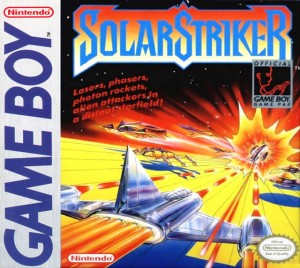
Solar Striker
Genre: Shoot ’em Up
Released: 1990
Back when Nintendo wasn’t necessarily associated with innovation so much as it was known for making completely random stuff, the company made games like Solar Striker, a shoot ’em up for Game Boy (remember that?) that propelled players into battle with evil aliens from the planet Turin. As the pilot of the titular Solar Striker, players shot hundreds of enemies through six stages, getting power-ups that enhanced their speed and power as they went. And after all that, players could play it all over again– except in Hard Mode.
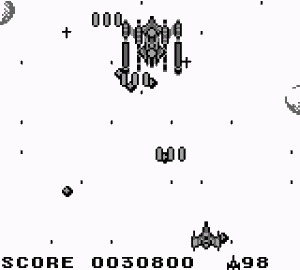 Suffice it to say that even in 1990, this wasn’t the most original game concept ever. (Hudson’s Star Soldier certainly had a thing or two to say to Solar Striker.) Yet the game was directed by Satoru Okada and Keisuke Terasaki– the former now helps design Nintendo’s handhelds and the latter went on to work on everything from Teleroboxer to Mother 3— and produced by none other than Shigeru Miyamoto’s mentor, Gunpei Yokoi. While Solar Striker was among Okada and Terasaki’s first games, their craftsmanship still shows in that the game’s not buggy, the hit boxes are normal (important for a shmup!) and there aren’t so many enemies that your head starts spinning. That said, there’s just not that much to say about Solar Striker— it’s just too generic. Though it is the only shoot ’em up Nintendo ever created, so that’s as good a claim to fame as any.
Suffice it to say that even in 1990, this wasn’t the most original game concept ever. (Hudson’s Star Soldier certainly had a thing or two to say to Solar Striker.) Yet the game was directed by Satoru Okada and Keisuke Terasaki– the former now helps design Nintendo’s handhelds and the latter went on to work on everything from Teleroboxer to Mother 3— and produced by none other than Shigeru Miyamoto’s mentor, Gunpei Yokoi. While Solar Striker was among Okada and Terasaki’s first games, their craftsmanship still shows in that the game’s not buggy, the hit boxes are normal (important for a shmup!) and there aren’t so many enemies that your head starts spinning. That said, there’s just not that much to say about Solar Striker— it’s just too generic. Though it is the only shoot ’em up Nintendo ever created, so that’s as good a claim to fame as any.
Though in the current era, it’s an interesting exercise to think about what Nintendo could do with certain types of games if it really tried. Solar Striker might just be something to innovate.
Why We Liked it: Shoot ’em ups on the go? Sign me up, I love Star Soldier!
Why We Forgot it: Wait, Super Star Soldier just came out on the TurboGrafx-16? Forget this, I want color.
Why We Want it Back: Nintendo’s proven itself to consistently make old things new again– we just want to fall back in love with shoot ’em ups.
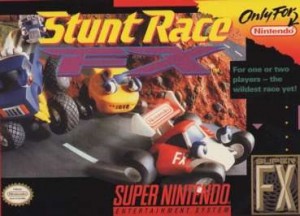
Stunt Race FX
Genre: Racing
Released: 1994
In 1992, Nintendo developed and published Super Mario Kart, a racing game unlike any other racing game so far, mostly because it had a) Mario-themed tracks, b) Mario-themed items and c) Mario-themed characters. Then, in 1993, Nintendo teamed up with fledgling Argonaut Software to develop and publish Star Fox, a flight simulator unlike any other flight simulator so far, mostly because it had a) animals piloting the ships, b) in space, c) while bantering all over the place. Clearly Nintendo had something awesome on its hands with these games, and as we can see now, Mario Kart and Star Fox have definitely come into their own since those early days. But Stunt Race FX? That’s a different story.
In 1994, flush from their lovely new partnership together, Nintendo and Argonaut decided to make another video game effort in the form of Stunt Race FX, a game seemingly fused together from all the spare parts left from Super Mario Kart and Star Fox‘s development, supercharged once again with the FX chip. It had the cartoonish quality of Super Mario Kart, certainly, but no Mario characters; the three-dimensional wow-ness of Star Fox permeated it too, but without most of that same wow factor. In fact, Stunt Race FX looked a lot like what Pixar’s Cars might have looked like if it were made in 1994, and that’s not exactly a compliment.
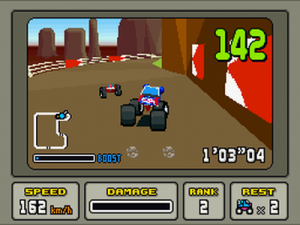
Bright and colorful, Stunt Racer FX still looked more toy-ish than anything.
It’s unfortunate that superficially, Stunt Race FX was somewhat inadequate, because it controlled like a dream– doing away with the items from Super Mario Kart, Nintendo and Argonaut instead put the focus on racing, something Nintendo had done previously with 1990’s F-Zero. The interface, too, was uncluttered and easy-to-read, all while giving vital information. The FX chip, though, was the star of the show, though to whose benefit it was unclear– later on, Nintendo would make more subtle use of the chip in games like Super Mario World 2: Yoshi’s Island, where it was used in backgrounds to charming effect.
Needless to say, Nintendo never worked on a sequel, as poor sales (but positive reception!) made the company less than enthusiastic about it. Perhaps not coincidentally, Argonaut only worked on two other games for SNES after Stunt Race FX— Ren & Stimpy: Fire Dogs and Scooby Doo Mystery. Though with Nintendo, racing series are always hard-pressed for survival. There will always be a Mario Kart game. F-Zero? Not so much.
Why We Liked It: I’m not old enough to drive, but I can drive here! Hooray, escapism!
Why We Forgot It: I think I like Mario better than this anthromorphized coupe. Yeah, I definitely do.
Why We Want It Back: Anthromorphic cars are quaint rather than overdone now! … Wait.
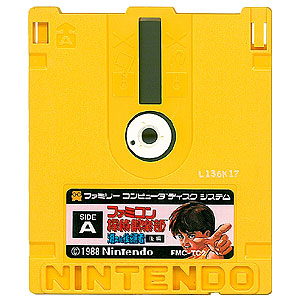
Famicom Detective Club
Genre: Adventure
Released: 1988
Gunpei Yokoi’s known for a lot of things, but Famicom Detective Club— or Famicom Tantei Club, we guess, since it was never released in Japan and we like to pretend we know Japanese because it makes us sound impressive– always gets lost in the dust. The first game in the series was released on the Famicom Disk System, and while it wasn’t the only first-person adventure game on the market, it certainly was the first one to feature a teenage boy instead of grizzled veterans like Jake Hunter (who, despite his advanced experience, still remains on the crime scenes today).
Like Encyclopedia Brown and the Boxcar Children before him, the unnamed protagonist (he’s got amnesia) traverses dangerous situations, from corrupt corporations to claustrophobic mansions (pre-Resident Evil), completely proving that people lose all usefulness when they become adults; heck, the protagonist falls off a cliff in the beginning of the game and manages to survive. Unlike Encyclopedia Brown and the Boxcar Children, though, the protagonist only got three games total before Nintendo decided it didn’t really feel like developing the Japanese equivalent of the Hardy Boys anymore. Heck, the third game in the series, BS Detective Club: Lost Memories in the Snow, can’t even be played anymore, since it was transmitted exclusively from Satellaview. Talk about a bummer.
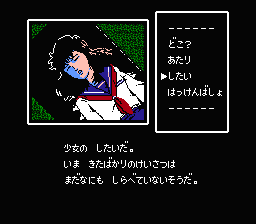
Thing is, Famicom Detective Club and its ilk, with its combination of first-person visuals and text-based story progression, is responsible for a whole lot of adventure gaming today– especially when coupled with Western adventure games like The Secret of Monkey Island or King’s Quest, which were similarly text-based. From Hotel Dusk: Room 215 to Capcom’s Ace Attorney series, to even Professor Layton’s smash series, Famicom Detective Club and Jake Hunter have successors to spare. It’s just too bad this seventeen-year-old could survive being pushed off a cliff and not the ever-changing tides of gamer tastes.
Why We Liked It: Wow! I feel just like Sherlock Holmes! I wonder if this will inspire some kind of lawyer game.
Why We Forgot It: I can’t read Japanese! But if I could, I’d probably be distracted with all the Mario going on.
Why We Want It Back: Wait, but this looks just like Phoenix Wright: Ace Attorney. What a rip-off.
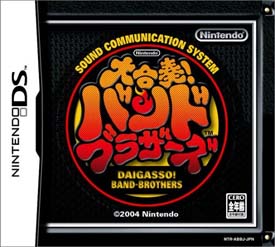
Daigasso! Band Brothers
Genre: Rhythm/Music
Released: 2004
Leaping forth almost two decades, let’s take a look at Daigasso! Band Brothers, a game not so much forgotten as it is only duly remembered. Though it was supposed to release outside of Japan at some point, Daigasso! Band Brothers never really got out of the country. And it’s not hard to imagine why not– in the Japanese game, Daigasso! Band Brothers holds no less than 38 songs culled from everything from folk songs to video game soundtracks to J-Pop tracks from Orange Range and L’Arc~en~Ciel. And while these songs were all instrumental-only– no, the DS mic isn’t that robust– licensing issues likely prevented Nintendo from putting 38 quality songs into a North American release. (The European equivalent of Daigasso!‘s sequel, Jam with the Band, appeared in 2010.) If anything, the game would turn out like the Donkey Konga series, with subpar cover versions of head-tilting song choices. And nobody would want that, right?
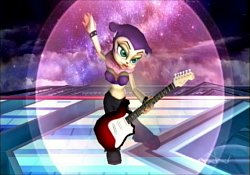 Well, actually, it turns out we might. Daigasso! Band Brothers is a lot like the internationally released and monstrously underrated Wii Music, in that (at least in the normal difficulty) players merely tap buttons for varying amounts of time, sometimes making stuff up while hoping it sounds good. And while the gaming press didn’t seem to enjoy Wii Music too much (and thus, probably wouldn’t have liked Daigasso! Brand Brothers), millions of sales don’t lie. In any case, Daigasso! Band Brothers, even without a robust song library, might just have sold pretty well, considering it would have come out at a time when cooperative musical gameplay was practically unheard of. Heck, even now, Daigasso! Band Brothers‘s multiplayer jam modes, with support for up to eight people, is still pretty darn impressive.
Well, actually, it turns out we might. Daigasso! Band Brothers is a lot like the internationally released and monstrously underrated Wii Music, in that (at least in the normal difficulty) players merely tap buttons for varying amounts of time, sometimes making stuff up while hoping it sounds good. And while the gaming press didn’t seem to enjoy Wii Music too much (and thus, probably wouldn’t have liked Daigasso! Brand Brothers), millions of sales don’t lie. In any case, Daigasso! Band Brothers, even without a robust song library, might just have sold pretty well, considering it would have come out at a time when cooperative musical gameplay was practically unheard of. Heck, even now, Daigasso! Band Brothers‘s multiplayer jam modes, with support for up to eight people, is still pretty darn impressive.
Now all we need is to get rid of that creepy NiGHTS-esque mascot and we’re good to go.
Why We Liked It: A simultaneously cooperative and competitive music game? For eight players? WHAT.
Why We Forgot It: Boy, we wish this game came out in English. Er, everywhere.
Why We Want it Back: A simultaneously cooperative and competitive music game? For eight players? WHAT.
We know you’ve got a great collective memory, Nintendojoites. Let us know what franchises should come back in the comments below!
Many thanks to Autowitch, whose forgotten television was used for the masthead in this article.




 ShareThis
ShareThis







uniracers was pretty fun too, although i personally didn’t like stunt race fx…. although argonaut did go on to make some great games.
I saw that game a LOT around the Toys ‘R Us by me. For some reason they bought a lot, but never sold too many. Something about unicycles being silly.
Uniracers was one of my all-time faves on SNES. I came back to it repeatedly over the years, which is my main way of knowing if a game’s a classic. Silly Pixar lawsuit.
Daigasso! Band Brothers is the first game I’ve ever imported (from the now defunct Lik-Sang) back in 2005. The whole reason for getting it was that there was a special where the game was free if you purchased a DS, and I wanted to get that awesome pink DS Phat so my sister could play multiplayer games with me. In slightly more recent times, I picked up the matching GBA expansion cart off of eBay.
It just makes me sad that Jam With the Band got a 4/10 on Gamespot, whereas Daigasso! Band Brothers DX scored a 9 / 9 / 9 / 10 – (37/40) with Famitsu. :(